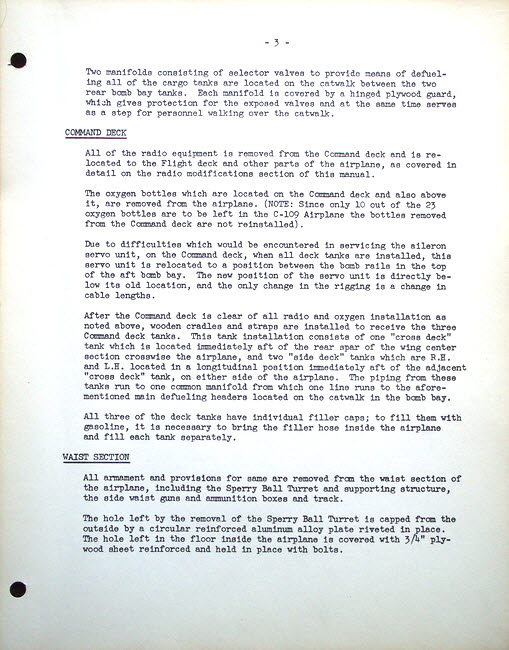
|
|
 |
Many thanks to Paul Stahl Jr, for sending us this modification manual for the C-109 fuel transport, an modified verison of the B-24 bomber. His father, Paul Stahl Sr, was the project engineer for the C-109.
TEXT
Page 3 - Section 1 - Introduction to C-109 Airplanes
Two manifolds consisting of selector valves to provide means of defueling all of the cargo tanks are located on the catwalk between the two rear bomb bay tanks. Each manifold is covered by a hinged plywood guard, which gives protection for the exposed valves and at the same time serves as a step for personnel walking over the catwalk.
COMMAND DECK
All of the radio equipment is removed from the Command deck and is relocated to the Flight deck and other parts of the airplane, as covered in detail on the radio modifications section of this manual.
The oxygen bottles which are located on the Command deck and also above it, are removed from the airplane. (NOTE: Since only 10 out of the 23 oxygen bottles are to be left in the C-109 Airplane the bottles removed from the Command deck are not reinstalled).
Due to difficulties which would be encountered in servicing the aileron servo unit, on the Command deck, when all deck tanks are installed, this servo unit is relocated to a position between the bomb rails in the top of the aft bomb bay. The new position of the servo unit is directly below its old location, and the only change in the rigging is a change in cable lengths.
After the Command deck is clear of all radio and oxygen installation as noted above, wooden cradles and straps are installed to receive the three Command deck tanks. This tank installation consists of one 'cross deck' tank which is located immediately aft of the rear spar of the wing center section crosswire the airplane, and two 'side deck' tanks which are R.H. and L.H. located in a longitudinal position immediately aft of the adjacent 'cross deck' tank, on either side of the airplane. The piping from these tanks run to one common manifold from which one line runs to the afore-mentioned main defueling headers located on the catwalk in the bomb bay.
All three of the deck tanks have individual filler caps; to fill them with gasoline, it is necessary to bring the filler hose inside the airplane and fill each tank separately.
WAIST SECTION
All armament and provisions for same are removed from the waist section of the airplane, including the Sperry Ball Turret and supporting structure, the side waist guns and ammunition boxes and track.
The hole left by the removal of the Sperry Ball Turret is capped from the outside by a circular reinforced aluminum alloy plate riveted in place. The hole left in the floor inside the airplane is covered with 3/4" plywood sheet reinforced and held in place with bolts.